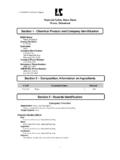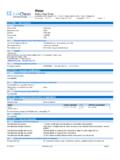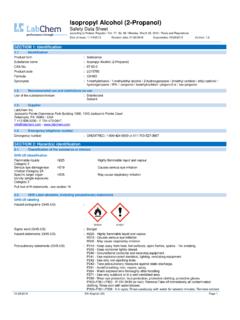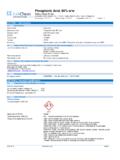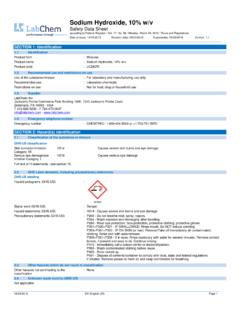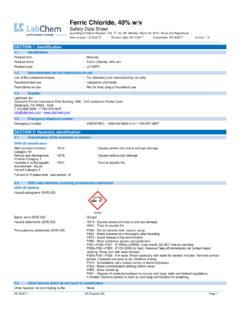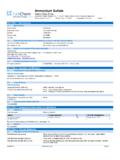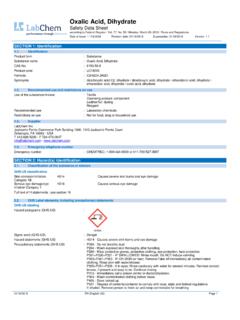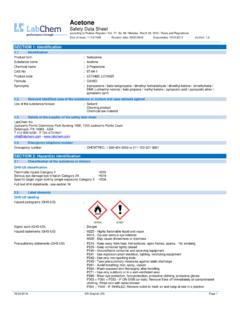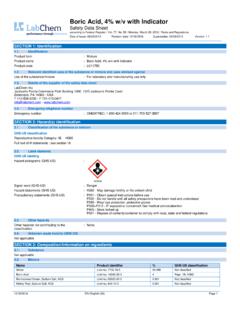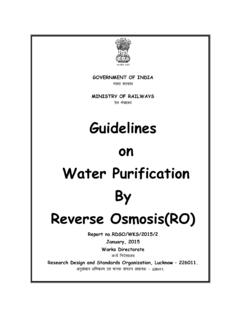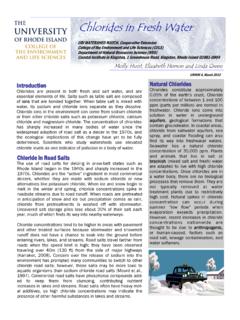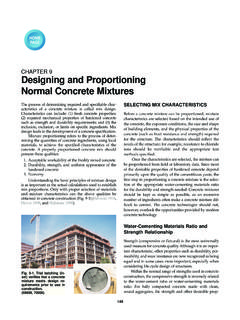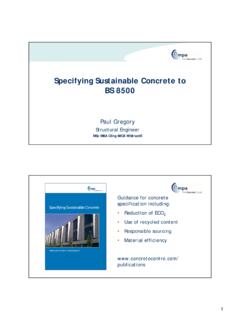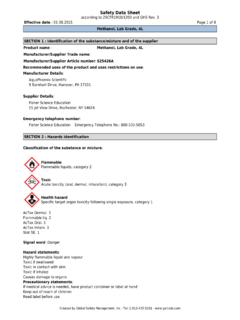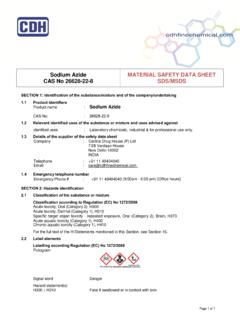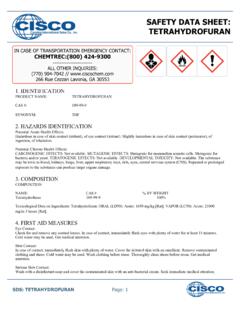Transcription of Formaldehyde, 37% w/w
1 Formaldehyde, 37% w/w Safety Data Sheet according to Federal Register / Vol. 77, No. 58 / Monday, March 26, 2012 / Rules and Regulations Date of issue: 11/15/2013 Revision date: 02/27/2014 Supersedes: 11/15/2013 Version: SECTION 1: Identification of the substance/mixture and of the company/undertaking Product identifier Product form : Substance Substance name : Formaldehyde, 37% w/w CAS No : 50-00-0. Product code : VT310. Formula : CH2O. Synonyms : formic aldehyde, 37% / formol, 37% / methanal, 37% / methyl aldehyde, 37% / methylene glycol, 37% / methylene oxide, 37% / oxomethane, 37% / oxomethylene, 37% / paraform, 37% /. tetraoxymethylene, 37%. Relevant identified uses of the substance or mixture and uses advised against Use of the substance/mixture : Chemical intermediate Disinfectant Laboratory chemical Details of the supplier of the safety data sheet Val Tech Diagnostics, A Division of LabChem Inc Jackson's Pointe Commerce Park Building 1000.
2 1010 Jackson's Pointe Court Zelienople, PA 16063. T 412-826-5230. F 724-473-0647. Emergency telephone number Emergency number : CHEMTREC: 1-800-424-9300 or 011-703-527-3887. SECTION 2: Hazards identification Classification of the substance or mixture GHS-US classification Flam. Liq. 3 H226. Acute Tox. 4 (Oral) H302. Acute Tox. 3 (Inhalation) H331. Skin Corr. 1B H314. Eye Dam. 1 H318. Skin Sens. 1A H317. Carc. 1B H350. Aquatic Acute 2 H401. Label elements GHS-US labelling Hazard pictograms (GHS-US) : GHS02 GHS05 GHS06 GHS08. Signal word (GHS-US) : Danger Hazard statements (GHS-US) : H226 - Flammable liquid and vapour H302 - Harmful if swallowed H314 - Causes severe skin burns and eye damage H317 - May cause an allergic skin reaction H318 - Causes serious eye damage H331 - Toxic if inhaled H350 - May cause cancer (Inhalation).
3 H401 - Toxic to aquatic life Precautionary statements (GHS-US) : P201 - Obtain special instructions before use P202 - Do not handle until all safety precautions have been read and understood P210 - Keep away from heat, sparks, open flames, hot surfaces. - No smoking 03/05/2014 EN (English) Page 1. Formaldehyde, 37% w/w Safety Data Sheet according to Federal Register / Vol. 77, No. 58 / Monday, March 26, 2012 / Rules and Regulations P233 - Keep container tightly closed P240 - Ground/bond container and receiving equipment P241 - Use explosion-proof electrical, ventilating, lighting equipment P242 - Use only non-sparking tools P243 - Take precautionary measures against static discharge P260 - Do not breathe mist, vapours, spray P264 - Wash exposed skin thoroughly after handling P270 - Do not eat, drink or smoke when using this product P271 - Use only outdoors or in a well-ventilated area P272 - Contaminated work clothing should not be allowed out of the workplace P273 - Avoid release to the environment P280 - Wear protective clothing, protective gloves, eye protection, face protection P301+P330+P331 - IF SWALLOWED: rinse mouth.
4 Do NOT induce vomiting P303+P361+P353 - IF ON SKIN (or hair): Remove/Take off immediately all contaminated clothing. Rinse skin with water /shower P304+P340 - IF INHALED: remove victim to fresh air and keep at rest in a position comfortable for breathing P305+P351+P338 - If in eyes: Rinse cautiously with water for several minutes. Remove contact lenses, if present and easy to do. Continue rinsing P308+P313 - IF exposed or concerned: Get medical advice/attention P310 - Immediately call a POISON CENTER or doctor/physician P333+P313 - If skin irritation or rash occurs: Get medical advice/attention P363 - Wash contaminated clothing before reuse P370+P378 - In case of fire: Use carbon dioxide (CO2), powder, alcohol-resistant foam for extinction P403+P233 - Store in a well-ventilated place.
5 Keep container tightly closed P235 - Keep cool P405 - Store locked up P501 - Dispose of contents/container to comply with local, state and federal regulations Other hazards Other hazards not contributing to the : None under normal conditions. classification Unknown acute toxicity (GHS-US). No data available SECTION 3: Composition/information on ingredients Substance Substance type : Multi-constituent Name : Formaldehyde, 37% w/w CAS No : 50-00-0. EC no : 200-001-8. EC index no : 605-001-00-5. Name Product identifier % GHS-US classification water (CAS No) 7732-18-5 48 - 53 Not classified Formaldehyde (CAS No) 50-00-0 37 Acute Tox. 1 (Inhalation:gas), H330. Carc. 1A, H350. Methanol (CAS No) 67-56-1 10 - 15 Flam. Liq. 2, H225. Acute Tox. 3 (Oral), H301. Acute Tox. 3 (Dermal), H311.
6 Acute Tox. 3 (Inhalation), H331. STOT SE 1, H370. Full text of H-phrases: see section 16. Mixture Not applicable SECTION 4: First aid measures Description of first aid measures First-aid measures general : Check the vital functions. Unconscious: maintain adequate airway and respiration. Respiratory arrest: artificial respiration or oxygen. Cardiac arrest: perform resuscitation. Victim conscious with laboured breathing: half-seated. Victim in shock: on his back with legs slightly raised. Vomiting: prevent asphyxia/aspiration pneumonia. Prevent cooling by covering the victim (no warming up). Keep watching the victim. Give psychological aid. Keep the victim calm, avoid physical strain. Depending on the victim's condition: doctor/hospital. 03/05/2014 EN (English) 2/12.
7 Formaldehyde, 37% w/w Safety Data Sheet according to Federal Register / Vol. 77, No. 58 / Monday, March 26, 2012 / Rules and Regulations First-aid measures after inhalation : Remove the victim into fresh air. Immediately consult a doctor/medical service. First-aid measures after skin contact : Wash immediately with lots of water (15 minutes)/shower. Do not apply (chemical) neutralizing agents. Remove clothing while washing. Do not remove clothing if it sticks to the skin. Cover wounds with sterile bandage. Consult a doctor/medical service. If burned surface > 10%: take victim to hospital. First-aid measures after eye contact : Rinse immediately with plenty of water for 15 minutes. Do not apply neutralizing agents. Take victim to an ophthalmologist. First-aid measures after ingestion : Rinse mouth with water .
8 Immediately after ingestion: give lots of water to drink. Do not induce vomiting. Immediately consult a doctor/medical service. Call Poison Information Centre ( ). Ingestion of large quantities: immediately to hospital. Take the container/vomit to the doctor/hospital. Do not give chemical antidote. Doctor: gastric lavage. Most important symptoms and effects, both acute and delayed Symptoms/injuries after inhalation : Runny nose. Coughing. Irritation of the respiratory tract. Irritation of the nasal mucous membranes. EXPOSURE TO HIGH CONCENTRATIONS: Possible oedema of the upper respiratory tract. Possible laryngeal spasm/oedema. Respiratory difficulties. Risk of lung oedema. Symptoms/injuries after skin contact : Caustic burns/corrosion of the skin. Symptoms/injuries after eye contact : Corrosion of the eye tissue.
9 Symptoms/injuries after ingestion : Nausea. Vomiting. Diarrhoea. AFTER ABSORPTION OF HIGH QUANTITIES: Central nervous system depression. Dizziness. Blood in vomit. Blood in stool. Shock. Disturbances of consciousness. Change in the haemogramme/blood composition. Change in urine composition. Urine discolouration. Chronic symptoms : ON CONTINUOUS/REPEATED EXPOSURE/CONTACT: Red skin. Dry skin. Skin rash/inflammation. Coughing. Possible inflammation of the respiratory tract. Respiratory difficulties. Indication of any immediate medical attention and special treatment needed Obtain medical assistance. SECTION 5: Firefighting measures Extinguishing media Suitable extinguishing media : Preferably: water spray. Alcohol-resistant foam. BC powder. Carbon dioxide. Unsuitable extinguishing media : No unsuitable extinguishing media known.
10 Special hazards arising from the substance or mixture Fire hazard : DIRECT FIRE HAZARD. Material presenting a fire hazard. INDIRECT FIRE HAZARD. Temperature above flashpoint: higher fire/explosion hazard. Reactions involving a fire hazard: see "Reactivity Hazard". Explosion hazard : INDIRECT EXPLOSION HAZARD. Reactions with explosion hazards: see "Reactivity Hazard". Reactivity : Upon combustion: CO and CO2 are formed. Reacts violently with (strong) oxidizers: (increased). risk of fire/explosion. Reacts violently with many compounds. Reacts with (some) acids: release of (highly) toxic compounds. Unstabilized product polymerizes. Reacts with (some) bases: release of carbon dioxide with pressure rise and possible bursting of container. Advice for firefighters Firefighting instructions : Cool tanks/drums with water spray/remove them into safety.
